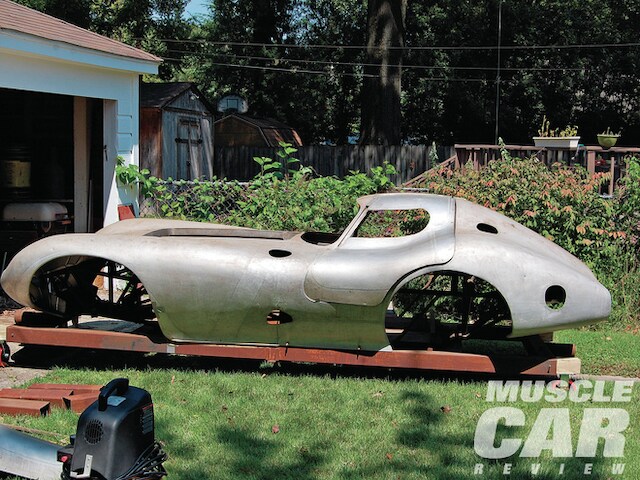Here's info on the original, one-and-only, 427 Chevy (the intended engine) Super Cheetah from 1964.
First, we are the manufacturer for the Bill Thomas Cheetah. We are BTM,” Robert Auxier says. No wonder he was so thrilled to have uncovered the one and only 427 Super Cheetah, a big-block coupe set to do battle with another supercar of the era, Carroll Shelby’s 427 Cobra Super Coupe, which was also stillborn.
“What did you think when you opened the barn door to find the car?” I ask.
“I couldn’t believe my eyes,” Robert answers.
The date was August 4, 2011. The expectation level must have been off the charts because he had been researching and hunting this car for more than two decades. He says, “In 1991, I started doing research on the Cheetah. And I talked to a friend of mine back in Chicago about the Cheetahs and the Super Cheetah. By coincidence, his best friend’s son was going to school with the nephew of the owner of the Super Cheetah in Tennessee. He got the nephew to show it to him in the garage 21 years ago.”
Enthused, Robert got the name and address of the owner and called him. Alas, the Super Cheetah wasn’t for sale.
“I talked to that man two or three times a year,” says Robert. “And then he passed away in 2010. The family knew who I was, and we made a deal on September 12, 2011.”
Robert could not have been more fortunate with the remains. Apparently, the owner, William Duke, had preserved the Super Cheetah exactly as he purchased the historic big-block sports/muscle car in 1971. Here are the odd facts of the deal.
Bill Thomas’ Cheetah operation in Anaheim, California, was very short-lived, starting in January 1964. Robert called the Cheetah a “top secret program” funded clandestinely by Chevrolet to compete against Shelby’s Cobra. Chevrolet “pulled the plug” in May 1964 after production and sale of a mere 23 Cheetahs. All were coupes, 21 built in fiberglass and two in aluminum. Most were powered by fuel-injected 327s, but some used 377s, and one car even came with a 396.
Thomas didn’t kill the Cheetah immediately. He had planned a Super Cheetah, powered by a 427 NASCAR-bred big-block. The body was 3 inches wider, 2 inches taller, and a foot longer with similar front and sides but a totally different rear. How many did they build?
“Just one. This is it, the aluminum car,” Robert says. Thomas never did complete the build to turnkey status. The good news is Robert has the car exactly as it was when work stopped in July 1964.
Robert says, “There was a fire in October 1965. Luckily, the Super Cheetah was in another building and not damaged.”
The business finally folded in 1970 and sold cars at auction. Don Edmonds, in charge of design and production of the first Cheetah, did not intend to purchase a car. However, he raised his hand at $300 to raise the bidding on the Super Cheetah. The bid went no higher. Edmonds owned the exotic American big-block.
In 1971, Edmonds, who was rookie of the year at Indianapolis in 1957 and built Indy cars, advertised the Super Cheetah for sale in Competition Press. A William Duke of Memphis purchased the car for $1,575. He would keep the car the rest of his life. Robert says, “The man never touched the car. From the day he put it in there until I took it out, that car didn’t move.”
Robert did not see the car until August 4, 2011, even though he had been visiting with the owner for more than 20 years. He says, “The man would never let me look at the car. He never let anybody look at that car for 40 years.”
Robert believes Cheetah connoisseurs wrote off the Super Cheetah as lost in the Bill Thomas fire of 1965. He says magazines incorrectly reported the car destroyed by fire. He received the Super Cheetah as Edmonds sold it, almost 40 years before to the day. Robert says, “I have it exactly how it was when work stopped in July of ’64 on the original Bill Thomas jig table, exactly from 1964 as it is now. I didn’t even wash this thing. It still has the dirt and the dust on the body and chassis.”
The components include the exotic aluminum body, the doors, the chromoly tube chassis, front and rear windows, headlight covers, and a prototype 327 engine.
This engine, however, was just a core for mock-up. Robert tells us a 427 big-block bolts in the same position. This restyled Cheetah was going to become the 427 Super Cheetah. Robert’s mission is to complete the car as Bill Thomas would have in 1964. Then he plans to go one step further. After the restoration, Auxier’s company will re-create the car in a continuation series.
Already, BTM in Phoenix (
www.billthomascheetah.com) makes continuation Cheetahs in the first body style. Now it will also manufacture the 427 Super Cheetah. Enthusiasts will be able to purchase one of the wickedest muscle cars of the ’60s thanks to a Rare Find.
Do you have a Rare Find story to share? Contact Jerry Heasley at
[email protected].
http://www.hotrod.com/articles/mscp-1206-427-super-cheetah-rare-finds/





